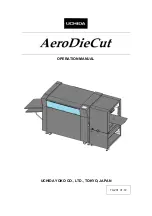
18
preventing it stagnating on the machine and clean the bottom
of the tank.
Whilst working the water will become deposited on the sup-
port surface and on the piece, then run into the tank via the
drainage openings. If the other parts of the machine come into
contact with the water, dry them with a soft cloth, only after
disconnecting the power cable from the electrical socket. The
floor must always remain dry.
See to restoring the water level should it drop due to eva-
poration.
Observe the following warnings that apply to all types of cuts:
- check that the screws are screwed tight
- keep the work piece firmly
- the piece must be resting against the piece guide
- keep a safety distance from the cutting area
- gradually and cautiously move the piece against the blade
- cut in a single stroke
- do not pull the cutting head too quickly in order not to
cause strain for the blade and the motor
- excessive strains cause the blade and/or piece to sud-
denly break
- do not strain the blade laterally
- the idle blade should not touch the piece
- do not start the machine if the blade is in contact with
the piece
- do not start the machine if the blade has no guard
- to clean use a long-handled brush
The machine allows various types of cut to be made, by put-
ting the cutting head on a slant and/or using the goniometer,
listed as follows:
- Cut perpendicular to the piece (fig.D)
Position the cutting head to 0° (the graduated scale is placed
to the side of one of the 2 rods) and fix it using the 2 flywheels
(pos.15).
Position the piece resting well on the piece guide (pos.7) using
the graduated scale as a reference.
- Tilted cut (from 0° to 45°) (fig.E)
Warning! This cut requires the blade to be more exposed,
increasing the risk of serious injuries: take care of your
hands and keep a safe distance.
Position the cutting head in order to form an angle between 0°
and 45° and fix it using the two flywheels (pos.15).
Position the piece resting well on the piece guide (pos.7) using
the graduated scale as a reference.
- Slanted cut (at 45°) (fig.F)
Position the cutting head at 0° and fix it using the 2 flywheels
(pos.15).
Assemble the goniometer (pos.8) on the piece guide and turn
it through an angle of 0° to 90°. Position the piece resting well
on the piece guide (pos.7) and on the goniometer.
- Combined tilted/slanted cut (fig.G)
Warning! This cut requires the blade to be more exposed,
increasing the risk of serious injuries: take care of your
hands and keep a safe distance.
Position the cutting head in order to form an angle between 0°
and 45° and fix it using the two flywheels (pos.15).
Assemble the goniometer (pos.8) on the piece guide and turn
it through an angle of 0° to 90°.
Position the piece resting well on the piece guide (pos.7) and
on the goniometer.
BLADE
WARNING! The cutting part can cause serious injuries, use
protection gloves and handle it with care!
1) Use good quality blades with the same characteristics as
the machine based on its technical data – your retailer will
be able to help you make the correct choice. Also observe
any instructions provided with the equipment.
2) Do not use blades if you do not know where they are from
or without technical specifications. They must show the
nominal dimensions, the maximum number of revolutions (or
speed) and the arrow that indicates the rotation direction.
3) The number of revolutions and the dimensions are the
basic elements for making your choice. The number of
revolutions must always be higher than that shown on the
machine. The dimensions must be equal to those shown
on the machine.
4) Use blades which conform to the regulations in force in
the country of use.
5) It is forbidden to use blades suitable for other materials,
abrasive discs or segmented crown blades.
6) Always carry out a visual check: there must be no defor-
mations, breakages or damages.
Our company provides a complete series of blades suitable for
your machine, which you can buy from your retailer.
BLADE REPLACEMENT (FIG. H)
WARNING! Before replacing parts, turn the switch to the
OFF “O” and unplug the machine from the electric power
supply.
WARNING! After cutting the blade reaches high temperatu-
res: Wait for it to cool down before replacing it.
WARNING! Even if the blade has stopped, it is still very
sharp: Use gloves to prevent serious injuries.
WARNING! The assembly of the blade must be carried out
with absolute precision. Incorrect assembly causes very
serious danger.
When replacing the blade, proceed as follows. The operation
must be carried out by an expert; if in doubt please contact
an authorised service centre.
1) Unplug the machine from the electric power supply.
2) For correct reassembly, observe carefully the various
components before proceeding.
3) Using a screwdriver, disassemble the side blade guard
(pos.3); do not disassemble the chain which has the job
of holding the guard in place and preventing start up if the
guard is disassembled.
4) Completely unscrew the nut (pos.30) using the spanners
provided, one to be inserted on the nut and one on the
shaft. Caution! the screw has a left thread, you must turn it
clockwise to unscrew it!
5) Remove the external flange (pos.31) and the blade (pos.2). The
internal flange must remain assembled on the motor shaft.
6) Clean the components, the new blade and the inside of
the guard.
7) Install the new blade observing the rotation direction: the bla-
















































